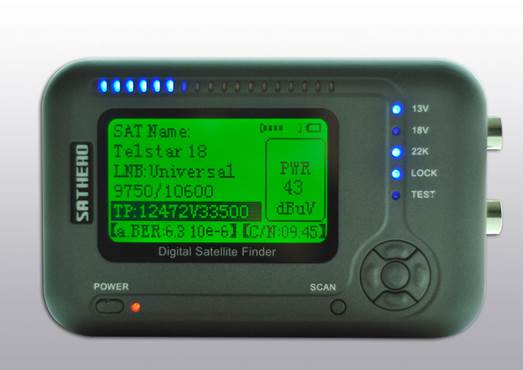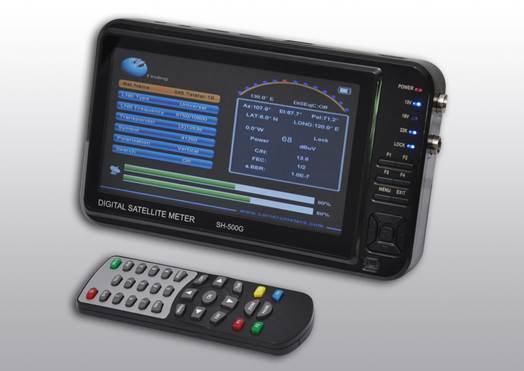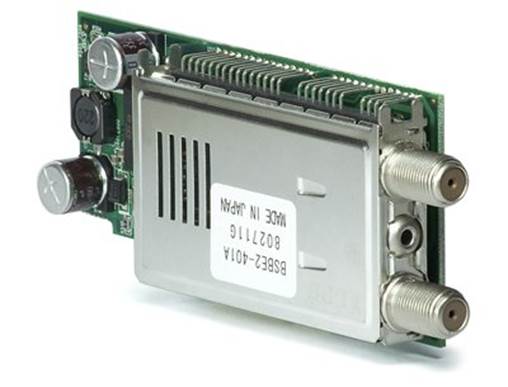This easy to use satellite meter may
have an interesting trick up its sleeve, but some aspects still need work
THE SH200 supports both DVB-S and DVB-S2
standards, as well as others (such as Japan’s ISDB). It won’t withstand the
hard knocks of professional use and is geared towards ‘caravans and tourers’.
The lozenge-shaped ABS box isn’t as tough
as the FS1 we reviewed last issue from the same supplier, CDtronix, and the
mounting point for the wrist strap is rather flimsy.

Sathero
SH200
On one side is a pair of F-connectors. One
is connected to the LNB, while the other provides a ‘cable-test’ mode. Connect
a cable between the two sockets, and it’s checked for simple short-circuits or
coax-core ‘continuity’; it’s won’t identify the problems that a kinked cable
could cause. Existing cables running from dish to receiver can’t be checked,
unless you temporarily run another length of cable and join the two at one end
with a F-coupler.
This second socket doesn’t support loop through,
and so a receiver cannot be attached simultaneously. On the opposite side of
the case is a USB port for a charger and it can also be connected to a PC via
the supplied RS232 cable; as we shall discover, the SH200 lacks a ‘true’ USB
port.

The
very readable backlit dot-matrix LCD screen indicates the selected satellite,
transponder, polarity and LNB settings
The very readable backlit dot-matrix LCD
screen indicates the selected satellite, transponder, polarity and LNB
settings. At the bottom of the screen, the transponder’s bit error rate (BER)
and carrier-to-noise ratio are displayed. Signal strength (dBuV, identified as
‘PWR’) and the satellite’s orbital position are also shown. The latter is
derived from the transponder’s NIT (network information table), and confirms
the satellite your dish is currently pointed at. Outdoor types will definitely
appreciate this!
Above it is an excellent bar graph,
constructed from 18 highly visible blue LEDs. To ease ‘dish-peaking’, it has a
wide dynamic range and is augmented by a potent (and un-switchable!) ‘chirping’
noise to audibly indicate signal strength; the faster its rate, the stronger
the signal. A separate column of LEDs confirm LNB voltage, signal lock, 22kHz
tone activity and the cable test mode.
Around the base of the screen are a ‘power’
button, a handy ‘scan’ button (which searches for and lists, courtesy of the
NIT – channels on the current transponder) and a ‘joypad’ for navigating the
simple but intuitive menu system. From here, you can edit the frequency and
symbol rate of the transponder by pressing ‘enter’ and raising/lowering each
digit in turn.
Verdict
The SH200 worked reliably overall, and its
metering proved to be useful. However, activating the ‘scan’ function would
occasionally reset the meter. It’s supported with new firmware and
satellite/transponder data. These, together with the program that initiates
transfers over the USB-to-serial cable, are available free of charge to
registered users. Transponder lists take the form of Excel-type spreadsheets,
and so manual editing is possible.
Unfortunately, the PC software didn’t work
properly in our tests on a Windows XP machine. It was impossible to select a
functional RS232 port, and the poor SH200’s USB implementation is our biggest
complaint of all.
The ‘USB charger’ operates at 10 volts, and
doesn’t adhere to the (5volt) USB specification. Not only will this spell death
for any ‘true’ USB device it’s accidentally plugged into, but means you can’t
charge the meter from conventional USB sources.

The
SH200 worked reliably overall, and its metering proved to be useful
Ratings
Plus
§ Accurate
NIT function
§ Excellent
metering
§ Easy
to use
Minus
§ Not
robust enough
§ Non-standard
‘USB’ lacks DiSEqC support
§ Build:
7/10
§ Setup:
8/10
§ Searching:
8/10
§ Navigation:
8/10
§ Performance:
8/10
§ Features:
8/10
§ Value:
7 stars
§ Overall: 7.8/10
Features
§ RF
connections: F-lugs for input and test
§ Other:
Non-standard USB (firmware/database updates, charger)
§ Freq
range: 950-2050MHz
§ LNB
compatibility: User definable local oscillator frequency, 22kHz switching,
13/18V polarity
§ Signal
metering: Level (audible confirmation, level in dBuV and blue LED bar grahp),
C/N ratio, BER and NIT data
§ Dish
alignment: No
§ Symbol
rate: 2Msps-45Msps
§ Accuracy:
Not specified
§ Battery
life: 3.5 hours from user-replaceable 1850mAh lithium-ion pack
§ Memory:
Over 1,000 satellite/transponder locations
§ Weight:
0.3kg
§ Dimensions:
127x80x32mm
|